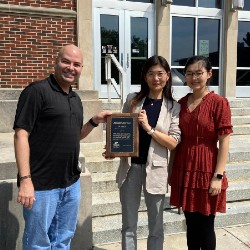Materials Engineering
Material engineers improve the road you travel on, the coal used to fuel a factory, and the sidewalk in your neighborhood. Through their study of
asphalt and bituminous materials, roads and sidewalks last longer and fuels, like coal, are more energy efficient.
The Materials area of emphasis in Civil Engineering provides freedom for students to develop a plan of study that will meet individual goals. Students take a broad range of courses including chemistry, construction, geology, mathematics, mechanics, and other engineering disciplines. Historically, the area has continuously maintained a balance between theoretical, experimental and practice-based approaches to solving problems. The Materials Engineering faculty are dedicated to teaching and research. The Materials Engineering Research Facilities offer hands-on experiences to undergraduate and graduate students.
Civil Engineering's Materials group has a loyal alumni network in both academia and private practice around the world. Research is divided into two broad themes: Asphalt and Bituminous Materials, and Portland Cement and Concrete. The American Concrete Institute at Purdue University also offers opportunities for students to bridge the gap between academic learning and professional practice.
Spotlights
August 31, 2022
PhD student Fabian B. Rodriguez has received a 2022 John Faber Scholarship from the American Coal Ash Association Educational Foundation (ACAAEF). The ACAAEF awards scholarships to graduate and undergraduate students with demonstrated interest in the management and beneficial use of coal combustion products (CCP).
July 15, 2022
Luna Lu, ACPA Professor and Founding Director of the Center for Intelligent Infrastructure at Purdue University's Lyles School of Civil Engineering, and her PhD student Zhihao Kong, have received the 2022 Alfred Noble Prize awarded by the American Society of Civil Engineers (ASCE) for their paper, "Improved Method to Determine Young’s Modulus for Concrete Cylinder Using Electromechanical Spectrum: Principle and Validation," published in Journal of Aerospace Engineering, November 2020.
July 6, 2022
PhD student Fabian B. Rodriguez has been named a member of the 2022 cohort of Trailblazers in Engineering Fellows, a group of 25 PhD students and postdocs in engineering or related disciplines at U.S. research universities selected to participate in a three-day professional development workshop that will prepare them to secure a position as a future engineering faculty and thrive in that role.
May 18, 2022
Constant construction on your vacation route, jarring potholes during the winter and bridge collapses will continue until roads are “smart enough” to better prevent their own damage, says Luna Lu, ACPA Professor of Civil Engineering.
May 13, 2022
PhD student Marina López-Arias has received the Spanish National Award for the Best Civil Engineering Master Thesis in the best quality category, presented by the Spanish Professional Engineers Association of Civil Engineers.
April 18, 2022
Luna Lu, ACPA Professor of Civil Engineering, has been elected as a Fellow of the Royal Society of Arts (RSA) for her entrepreneurial mindset in academia and innovations for enabling intelligent infrastructure.
February 7, 2022
The Asphalt Pavement Association of Indiana (APAI) has named CE students Klayton Davis and Luke Peters as 2021 APAI Scholars.
January 20, 2022
An NSF-funded research project led by Jan Olek and Pablo Zavattieri using 3D concrete printing to anchor offshore wind turbines is featured in the January 2022 edition of Concrete Products magazine.
December 21, 2021
Effective Jan. 1, 2022, Luna Lu, ACPA Professor of Civil Engineering, will take over as director of the Office of Professional Practice (OPP).
November 16, 2021
Transitioning to clean wind energy could become more cost-efficient as Purdue researchers test a new technology created by an international startup to anchor offshore wind turbines. Research on the anchors will be led by CE's Jan Olek and Pablo D. Zavattieri and MSE's Jeffrey P. Youngblood.
October 15, 2021
In October 2021, the Purdue University Board of Trustees ratified a $1.1 million gift made by Specification Products, Inc. The gift goes to further the education and research efforts at the Sustainable Materials and Renewable Technology (SMART) Laboratory — and has been renamed the Joe and Lisa Shetterley Innovation Lab.
May 27, 2021
Self-curing concrete, self-healing roads, and concrete that reduces the global carbon footprint. Purdue University engineers are looking at new ways to pave roads, ways to extend the life of roads and ways to make roadwork less resource- and carbon-intensive.
May 21, 2021
In the latest episode of the Engineering Management Institute's civil engineering podcasts, Dr. Luna Lu talks about intelligent infrastructure and how it can benefit civil engineers and the community.
March 12, 2021
A research project led by Prof. Luna Lu using sensors that could safely speed up a construction timeline by determining concrete strength directly onsite in real time has been featured in ASCE's Gamechanger series. The series highlights innovative engineering projects that provide essential services to American citizens through resilient, efficient, cost-effective and/or creative methods.
February 10, 2021
A team lead by Mirian Velay-Lizancos, assistant professor of civil engineering, proposes adding small amounts of nanoscale titanium dioxide to the cement paste that makes up concrete. The team found that titanium dioxide, a powdery substance known best for its uses in sunscreen, paints, plastics and food preservatives, enhances concrete's natural ability to sequester carbon dioxide.
February 10, 2021
Becky McDaniel made a lasting impression on the asphalt industry. A talented engineer and pragmatic researcher, she was a genuinely kind and compassionate person, a devoted wife and mother, whose 35-year career inspired a generation of academicians, practicing engineers and road-construction personnel. On May 2, 2020, Becky’s unexpected death left everyone she touched with a heavy heart. We are celebrating her contributions to our field through this symposium.
January 19, 2021
Pablo Zavattieri, Jerry M. and Lynda T. Engelhardt Professor in Civil Engineering, has been appointed to the Defense Materials, Manufacturing and its Infrastructure (DMMI) Standing Committee of the National Academies of Sciences, Engineering, and Medicine.
December 21, 2020
How long it takes to construct a building depends in large part on when the concrete of each floor is strong enough to take on loads. Purdue engineers have developed sensors that could safely speed up a construction timeline by determining concrete strength directly onsite in real time. Purdue’s Engineering and Polytechnic Gateway Complex is a test bed for the new technology.
October 23, 2020
Getting run over by a car is not a near-death experience for the diabolical ironclad beetle. How the beetle survives could inspire the development of new materials with the same herculean toughness, engineers show in a paper published Wednesday (Oct. 21) in Nature.
September 14, 2020
Dr. Luna Lu, ACPA Professor of Civil Engineering, was presented with the 2020 CE Outstanding Mentor of Engineering Graduate Students Award by the Civil Engineering Graduate Student Advisory Council (CEGSAC).



















